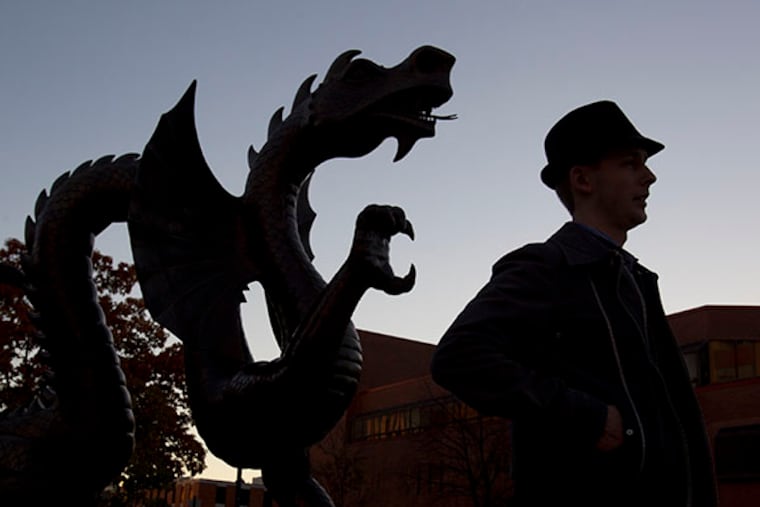Drexel's freshman applications plunge - happily
Applications for Drexel University's Class of 2019 have plunged by more than 50 percent from the previous year - but that's not a bad thing.

Applications for Drexel University's Class of 2019 have plunged by more than 50 percent from the previous year - but that's not a bad thing.
In fact, officials at the West Philadelphia university say that's exactly what they were hoping for.
The 27,424 applications are the result of a decision to hone an applicant pool that had ballooned to levels so unwieldy that some prospective students didn't even know what city Drexel was in.
This fall, the university, for the first time in many years, charged an application fee - $50 - and jettisoned its "VIP fast application," which required neither essays nor recommendations, and allowed students to apply with little more than a mouse click.
"They're not hurdles, but pause points," said Randall C. Deike, senior vice president for enrollment management and student success. "It requires a student and his or her family to say, 'Do I really want to spend $50 to go to this place?' "
The hope, officials said, is to attract applicants who are truly interested in Drexel and can succeed at a university known for a co-op program that sends most students into the workforce for a fifth year of study.
Drexel was in the minority by not charging a fee; applications to only 14 percent of four-year nonprofit colleges are free, according to a 2013 survey by the National Association for College Admission Counseling. Like most schools, Drexel waives the fee for low-income families.
Deike said Drexel hoped that by attracting more-interested applicants, it will keep them enrolled.
"We want to identify the right-fit student, because we believe they are best prepared to succeed and graduate, and that's our ultimate goal," Deike said.
Drexel's move is likely to become part of a trend as more universities are struggling to bring in a freshman class, said David Hawkins, executive director for educational content and policy at the admissions association.
"We've started to hear institutions really looking to reduce the volume of applications, coming after years of unprecedented and unrelenting increases," Hawkins said.
Boston College added an essay two years ago and saw a 26 percent decrease in applications. Ursinus College in Collegeville in 2011 saw its applicant pool fall by nearly one-third after it restored essay questions and ditched the fast application.
"It pretty unequivocally worked," said Richard DiFeliciantonio, Ursinus' vice president for enrollment, noting that a higher percentage of accepted students are enrolling and that this year's freshman class was larger than that of 2010.
When Drexel began its meteoric rise in applications, it was looking to grow. Under now-deceased president Constantine Papadakis, the university added medical and law schools and underwent a building boom. In 2005-06, the university started using a fast application, and enrollment has grown since then by 43 percent, to 26,359.
During that time, Drexel's applicant pool exploded by more than 300 percent, while other schools saw an increase of about 60 percent.
At the same time, its yield - the percentage of accepted students who enroll - fell to 8 percent, which is very low compared with a national average for private colleges of 35 percent.
To enroll a class of 2,925 freshmen, Drexel had to accept about 80 percent of its applicants.
"It wasn't a good way to do business," said Deike, who joined Drexel in September from New York University. "We were at some level doing a disservice to students."
He and others on campus acknowledged that shedding applicants could be risky, possibly affecting rankings and even bond ratings. It's also hard to predict how many students will enroll, and getting it wrong can mean empty dorm rooms or students housed in a hotel.
"There may be some painful moments," acknowledged Ludo C.P. Scheffer, a psychology professor who chairs the faculty senate and directs undergraduate studies, "and that worries me a little. As long as we keep people really informed . . . and people are fully involved, then we can manage that."
While Deike is confident that a higher percentage of students will enroll, other effects will take longer to gauge. Drexel hopes to raise its six-year graduation rate from 67.3 percent to 80 percent and increase its freshman- to-sophomore retention rate from 84 percent to 90 percent.
The reduction in applications is part of a strategy for admissions and student affairs expected to take hold over three to five years. The university reorganized the office, began building relationships with high school guidance counselors outside the region, and started awarding financial aid based more on need, Deike said.
Drexel has also applied differing admission criteria for various disciplines. In the past, students were judged by the same standard whether interested in studying English or biology.
"That differential criteria has already shown an impact on the success of the students in the first quarter in some of the majors," said Donna Murasko, a biology professor and dean of the College of Arts and Sciences. "Ultimately, we're going to have a more successful student body with these strategies."
215-854-4693 @ssnyderinq